With Trump’s DACA reversal, an art moment rises: how two works have acquired new significance
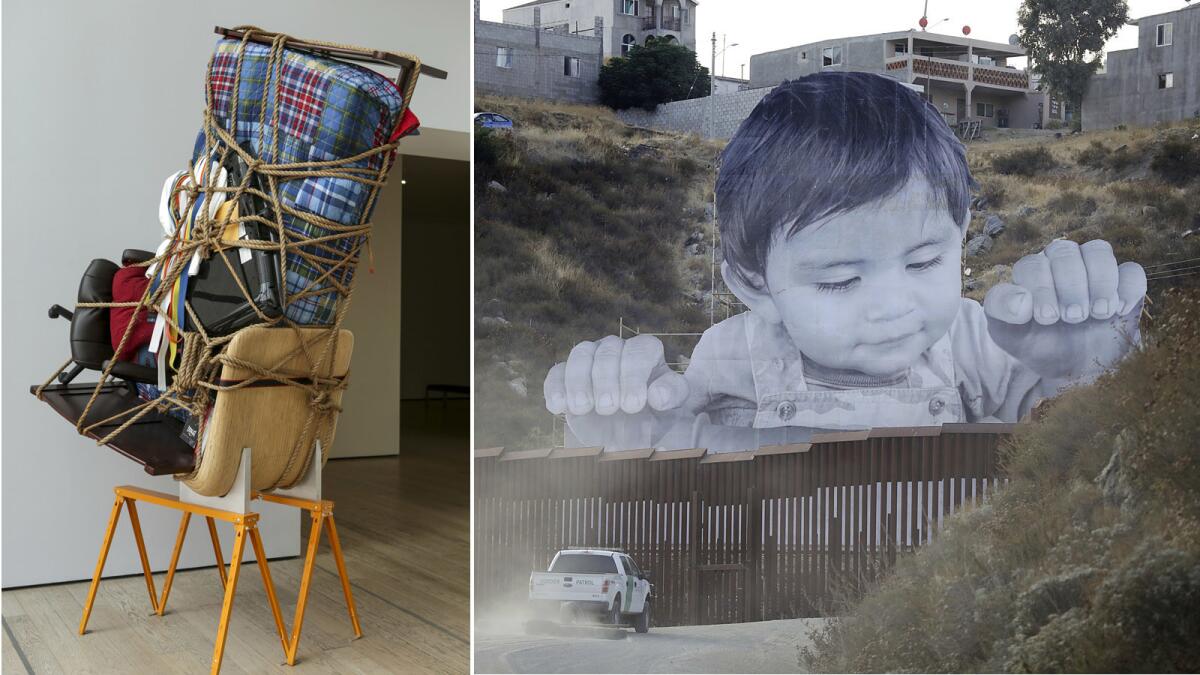
At first sight, the unwieldy bundle inside the
Formed into a sculpture by L.A. artist Camilo Ontiveros, these were once the belongings of Juan Manuel Montes, believed to be the first so-called Dreamer — a recipient of the
Far more sensational in scale is the massive photographic installation unveiled on the U.S.-Mexico border by the French artist known as JR just two days after the president announced his decision to phase out DACA. Located east of Tecate, it features a toddler peeking into the U.S. over the border wall and seems to call into question the idea that immigrant children pose a threat to a country as powerful as the U.S.
If immigration — and more specifically DACA — were to have an art moment, that moment is now.
In addition to artists in recent years taking their work directly to the border — from those who use the wall as a blank canvas on which to paint pointed imagery to a Japanese art collective that built a treehouse in Tijuana overlooking the wall — a number of works in Pacific Standard Time: LA/LA, the newly launched series of more than 80 exhibitions across Southern California, deal with immigration. The Ontiveros sculpture, “Temporary Storage: The Belongings of Juan Manuel Montes,” is part of LACMA’s Pacific Standard Time: LA/LA exhibition “Home: So Different, So Appealing.”
How artist Camilo Ontiveros acquired the belongings of a DACA deportee and what he did with them »
Many of these works have inserted a political urgency into the mainstream art world, an art world that frequently overlooks the Latino experience.
And yet I am not without ambivalence about the ways in which some artists tackle their subject.
I found myself tremendously moved by the sight of Montes’ belongings in the galleries at LACMA — objects that served as silent testimony on the issue of displacement.
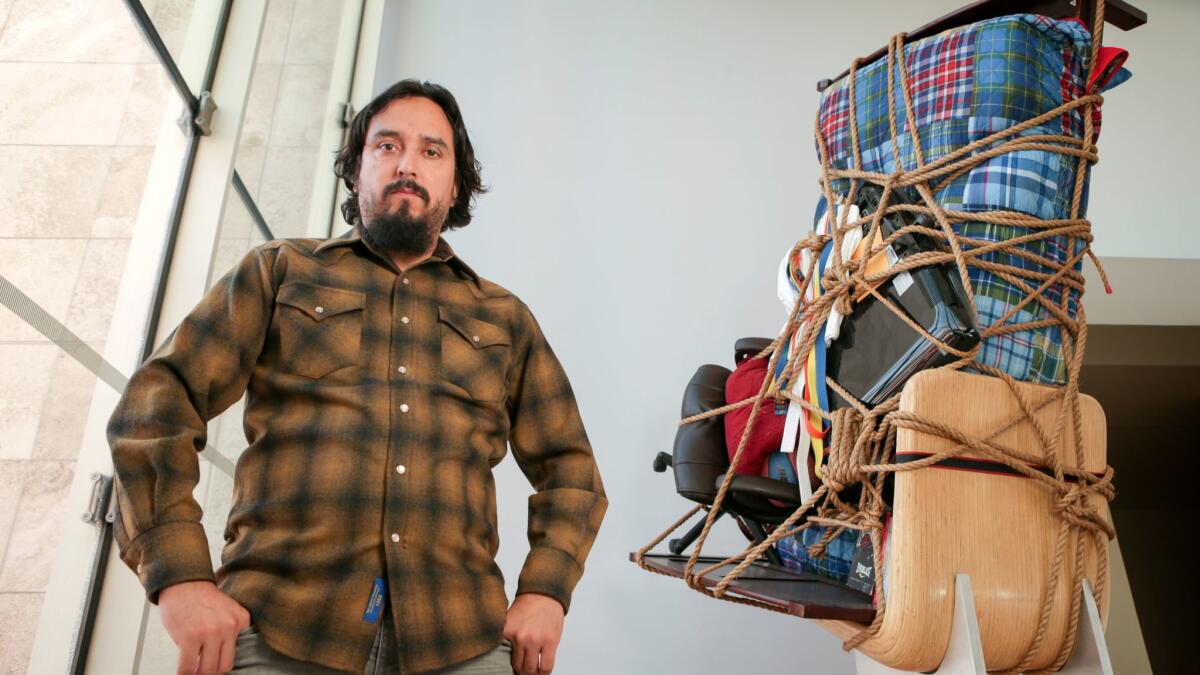
“They are the belongings of someone who is really vulnerable,” says Ontiveros of his sculpture, “someone who is taken away.”
I was less convinced by JR’s installation at the border.
His imagery — dramatic photo crops, intense close-ups, cinematic poses — all rendered in a black-and-white palette on a very large scale and relying heavily on repetition, borrows heavily from the language of advertising. A work by JR is instantly recognizable as a work by JR whether it resides on a roof in Los Angeles or a favela in Rio de Janeiro or the Palestinian territories. At what point do advertisements for community become advertisements for the globe-trotting artist who makes them? It can be hard to tell.
Certainly, JR’s piece is clever. There is something joyous about the sight of a Godzilla-sized toddler looking down over the border wall at a gaggle of Border Patrol agents — all rendered tiny by the work’s massive scale.
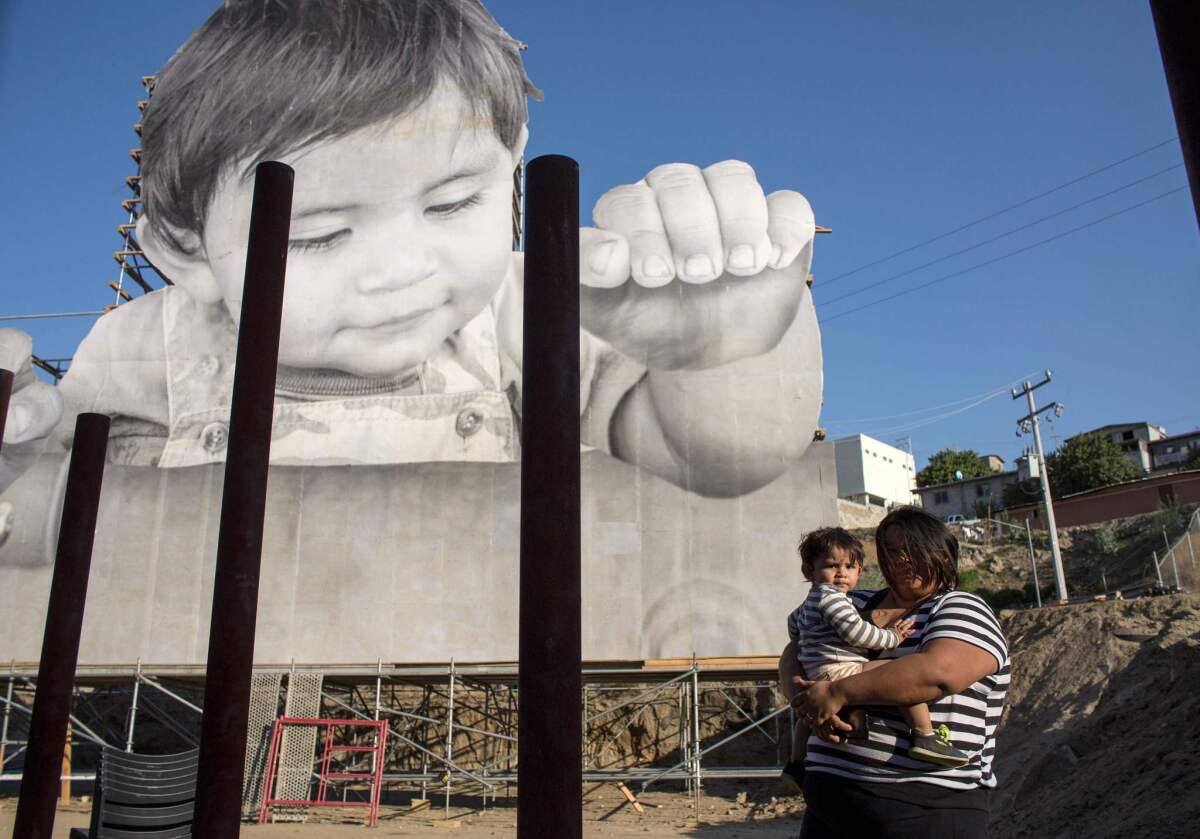
“The fact that it was a kid,” said JR at a talk at Blum & Poe gallery in Culver City earlier this month, “seemed to break all barriers.”
A French national of Tunisian descent, JR has a long-running interest in issues of immigration. He has created photographic installations around the plight of refugees and once installed a poster series of Israelis and Palestinians in humorous poses on the West Bank’s concrete barrier to show the commonality between the two sides. And while the very sight of JR’s works seems designed to go viral — as his border toddler did — he doesn’t work with commercial brands. Instead, he’s worked with director Agnes Varda, sharing credit on the documentary “Faces Places,” which premiered at Cannes earlier this year.
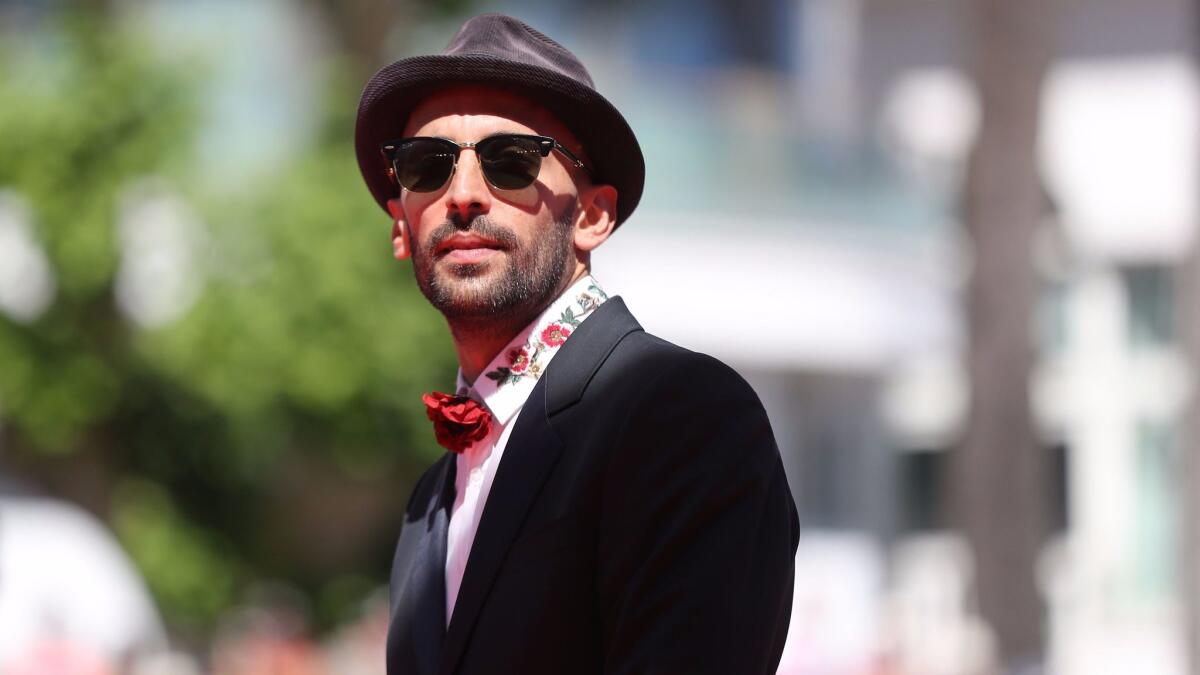
In orchestrating his artworks, he engages the local community — especially the marginalized and the elderly — for the creation of images, as well as their ultimate installation.
The decision to paste an image of a child at the border came from seeing toddler Enrique Achondo, nicknamed Kikito, who lives on the Mexican side of the border in Tecate, playing within sight of the wall.
“This kid is looking every day at the border,” JR said before the standing-room-only Blum & Poe crowd. “I wonder what he thinks because he has no idea what that means, what a border means.”
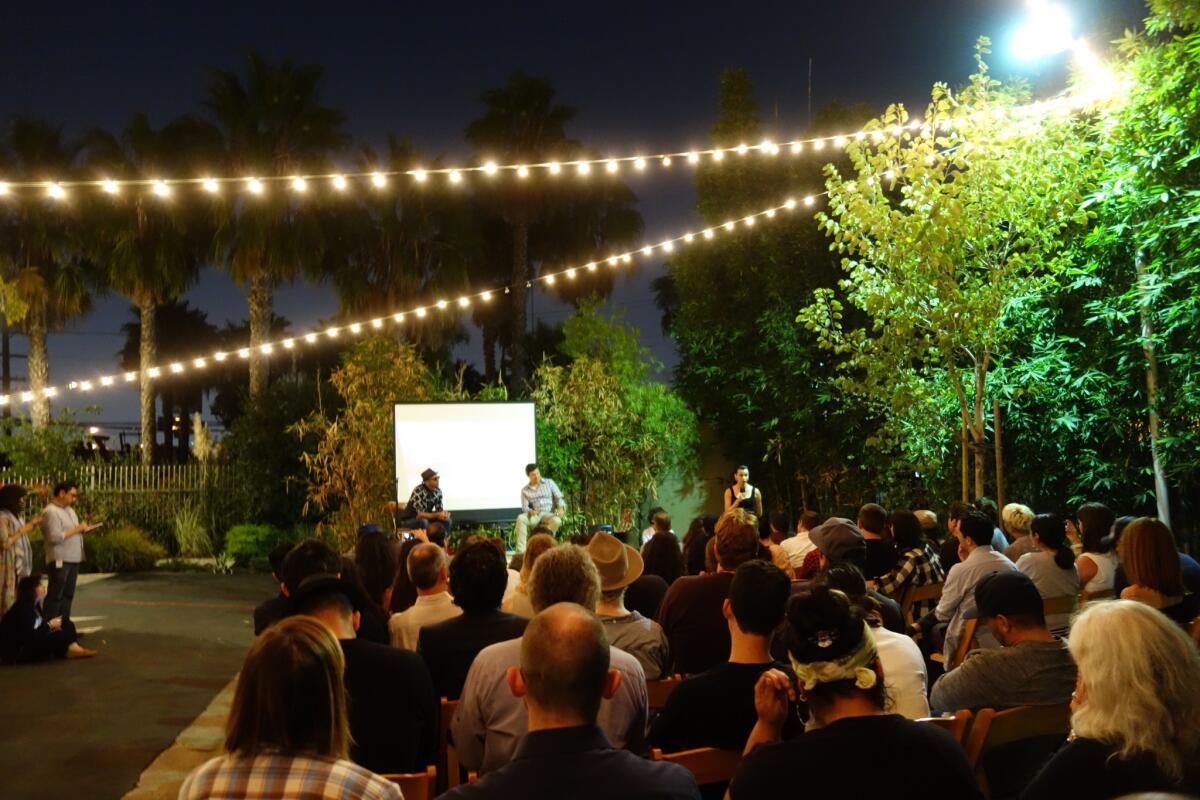
One reason he creates large-scale works is that it forces individuals in a community to work together in unusual ways. He could, he said, sit at home and create a similarly viral image using Photoshop.
“I could say the same thing by sitting at home on my computer ... asking friends, ‘Hey, post that up,’” he told The Times after his presentation, during which the artist retained his street cool by never removing his sunglasses. “We are all in our home, totally alone, talking the exact same message, but without the human contact.”
His Inside Out project encourages groups to submit their own portraits, which he then prints out at a large scale, so that people around the world can create their own installations. Since it first launched, the project, which is funded by the $100,000 TED Prize he received in 2011, has brought communities together to address violence in the Mexican border city of Juarez and the plight of refugees from the Western Sahara.
It’s a process and an intention that is practically beyond criticism: An artist who is interested in conditions faced by refugees and immigrants and wants to bring communities together — what curmudgeon would possibly want to criticize that?
Part of my discomfort with JR’s oversized border baby, like many of his works, lies in its magazine slickness. Moreover, the work, whose visual effects are visible only from the U.S.-side of the border, is distinctly one-sided.
But as 800,000 sort-of Americans, the DACA recipients, face uncertainty over their status in this country, do these quibbles matter?
In the months to come, there will be art made and displayed that takes DACA as a point of inspiration. It will likely be good, bad and everything in between.
All of it serves a role in the conversation we are having about the millions of migrants in the United States (not just DACA recipients) who face the uncertainty of life without papers.
“I don’t know that the art world is very prone to have these kinds of discussions,” says Ontiveros, a Mexican national who has lived in the U.S. since he was a teen — for the first five years without papers. “They want to talk about art objects.”
Yet with so many U.S. Latino and Latin American-themed shows opening in and around Los Angeles in connection with PST: LA/LA, some of those objects are taking difficult dialogues about immigration into the more visceral territory of art and spurring discussion about DACA — in ways both intentional and serendipitous.
“I saw it coming,” Ontiveros said of Trump’s DACA decision. “There has been a lot of skepticism about DACA since it started. … It’s really painful and really devastating for the immigrant community, that the government can just take something away like that.
“It’s always in the back of your head,” Ontiveros said. “Anyone who is here illegally, you are thinking about it.”
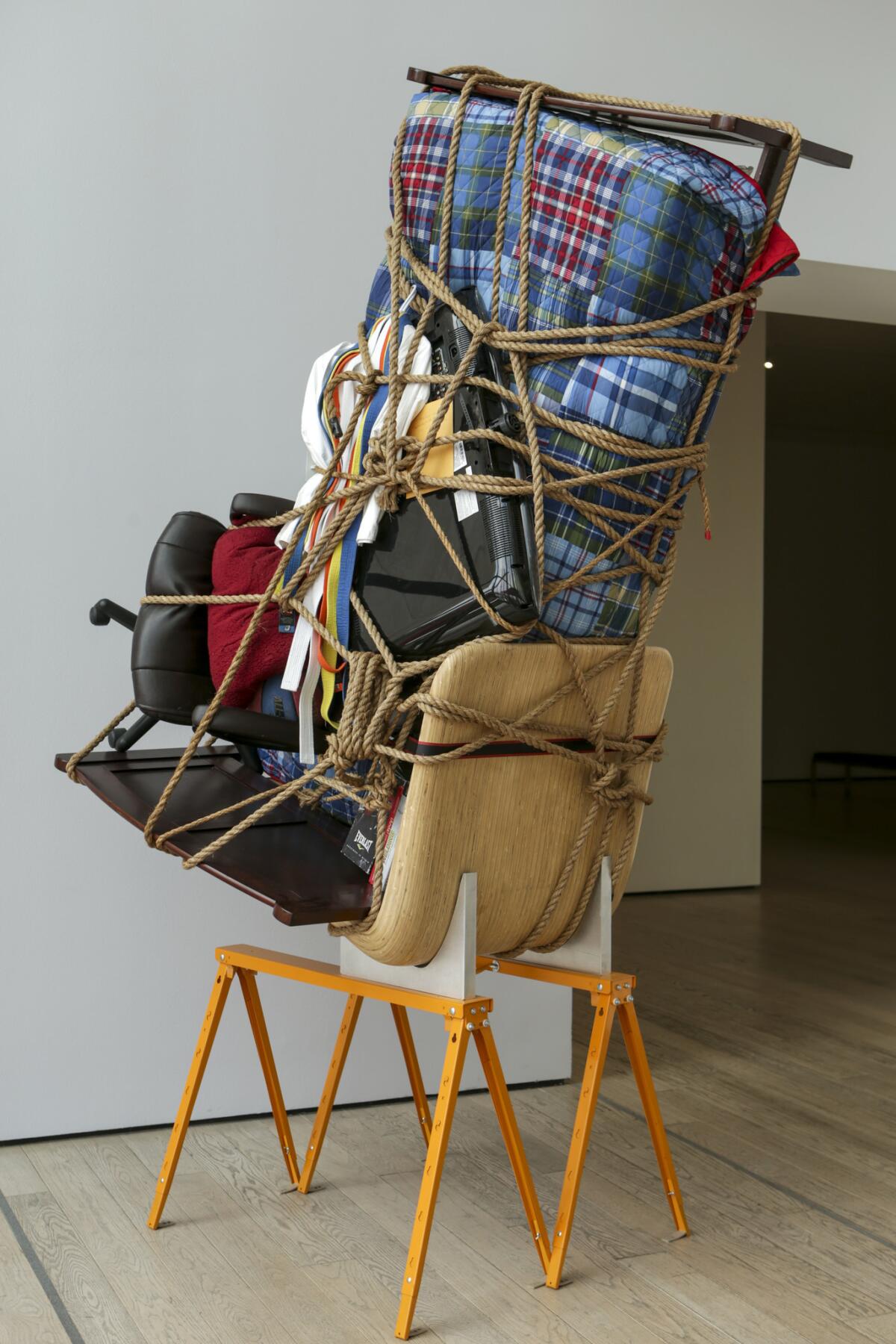
At the Craft & Folk Art Museum, the recently opened PST: LA/LA exhibition “The US-Mexico Border: Place, Imagination and Possibility” features an older work rendered current — a poster originally created by artist Rupert García in 1973 that reads: “¡Cesen Deportación!” — Cease Deportation!
At Avenue 50 studio in Highland Park, a solo exhibition of paintings by Malaquías Montoya includes two works dedicated to DACA recipients. And late next month, independent curator Isabel Rojas-Williams, formerly of the Mural Conservancy of Los Angeles, is opening a group show titled “South of the Border” at the Loft at Liz’s gallery.
Included in the exhibition will be images by photographers Yunuen Bonaparte and Adrián González, both of whom are DACA recipients and chronicle the DACA experience. Plus, comedian Johan Miranda (no relation) will perform a routine inspired by his experiences as an immigrant. He too is a DACA recipient.
It’s an important moment to hear from the voices of immigrants themselves — voices often left out of the wonk-ish policy debates, not to mention most museums and arts institutions.
And as I found out at Blum & Poe, there is power even in work by those in no fear of DACA-related deportation.
JR’s piece — inspired not by Trump’s reversal of DACA (which the president, in his negotiations with Democratic leaders, may now be amenable to maintaining), but by news reports earlier this year of political conflicts over the U.S.-Mexico border — was originally supposed to be installed in May.
But if the piece revealed this month has been seized as a rejoinder to the Trump administration, JR is OK with that.
“We had no idea at the time that it would take that meaning,” he said at Blum & Poe. “But I believe in serendipity.”
Then, as his nighttime talk at the gallery wound down, a young woman stood up and identified herself as a DACA recipient. Her voice quivering with emotion, she thanked the artist for his border image: “I came here because my parents had a dream and I have a dream.”
Sign up for our weekly Essential Arts & Culture newsletter »
ALSO
In a heated political moment, the ambitious Latino art series Pacific Standard Time: LA/LA opens
Did you spot the egg-shaped museum named NuMu cruising L.A.? Next stop: LACMA
The biggest entertainment stories
Get our big stories about Hollywood, film, television, music, arts, culture and more right in your inbox as soon as they publish.
You may occasionally receive promotional content from the Los Angeles Times.








